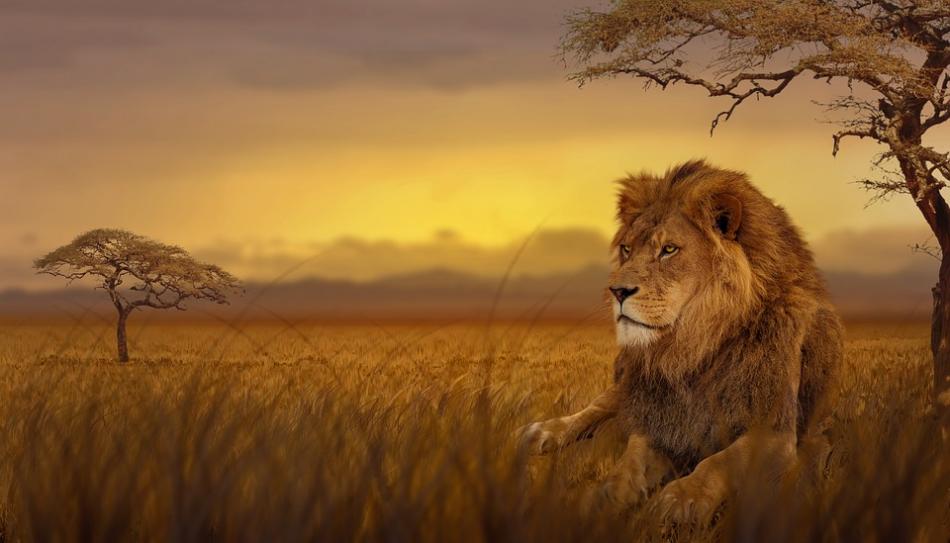THE AFRICAN LION

WHAT DO WE MEAN BY AFRICAN LION?
African lions have been admired throughout history as symbols of courage and strength. These iconic animals have powerful bodies. In the feline family, they are second in size after tigers; they let out roars that can be heard eight kilometers away. An adult lion's coat is yellow-gold, and young ones have some spots that disappear with age. Only male lions have a mane, this impressive fringe of long hair that surrounds their head.

WHERE DO AFRICAN LIONS LIVE?
African lions once roamed most of Africa and parts of Asia and Europe. But the species has disappeared from 94% of its historic range and is now found only in parts of sub-Saharan Africa. These lions primarily settle in grasslands, scrub or open forests where they can more easily hunt their prey, but they can live in most habitats other than tropical rainforests and deserts.

Asiatic lions (Panthera leo persica) are a subspecies of the African lion, but only a very small population survives in the Gir Forest of India.
THE KING OF THE SAVANNA IN HIS TROOPS
Lions are the only big cats that live in groups called troops - although there is a population of solitary lions. Troops are family units that can include two to 40 individuals, including up to three or four males, a dozen females and their young. All lionesses in a pride are related, and female lion cubs usually stay with the pride as they grow up. The young males eventually leave and establish their own troop by taking over a group led by another male.
Males defend the troop's territory by marking the area with urine, roaring menacingly to warn intruders, and chasing away encroaching animals.
Females are the main hunters and leaders of the pride. They often work together to hunt antelope, zebra, wildebeest and other large grassland animals. Many of these animals are faster than lions, so teamwork pays off. Lionesses also raise their cubs communally.

After the hunt, the meal often degenerates into quarrels over the sharing of the spoils, with the lion cubs being at the bottom of the ladder. Young lions do not help hunt until they are about a year old. Lions hunt alone if the opportunity presents itself, and they also steal animals killed by hyenas or wild dogs.
ARE AFRICAN LIONS THREATENED WITH EXTINCTION?
Today, there are half as many African lions as there were 25 years ago. The International Union for Conservation of Nature (IUCN) estimates that there are fewer than 25,000 lions left in Africa, which is why the organization classifies them as endangered.

These animals face a variety of threats, most of which can be attributed to humans. Fearing that lions will attack their livestock, which can represent a significant financial hit, herders kill them both in retaliation and as a preventative measure, sometimes using pesticides as poison. Poachers also target them because their bones and other body parts are valuable in the illegal wildlife trade.
The role trophy hunting plays is controversial. Poorly managed hunting in the past has caused lions to disappear from some habitats, while hunters and industry stakeholders say hunting rights generate money for lion conservation. National Geographic explorer Craig Packer, however, said that the money generated by hunting is so "insufficient... [that] it is no wonder that, despite years of lion hunting being permitted in [some ] country, the population has fallen.

The loss of prey throughout the species' range further fuels this conflict between lions and humans. African lions prey on large herbivores, a species that is hunted for the increasingly profitable bushmeat trade. The IUCN estimates that these populations have declined by 52% in East Africa and 85% in West Africa. With less food available in the wild, lions may turn to hunting domestic animals like livestock.
WHAT CAN BE DONE TO PROTECT THIS AFRICAN FELINE?
Helping humans learn to live with lions is essential to ensure their survival. Conservation organizations are working to change attitudes towards these animals through compensation initiatives. Some of these models offer communities financial rewards when their local lion population increases, while others pay farmers to replace their livestock killed by lions.

Other environmentalists have focused on creating protected areas for lions. In the Selinda region of Botswana, a single lioness and her cub lived there when filmmakers Derek and Beverly Joubert, both of National Geographic Explorers, transformed the land into a protected reserve and photo tourism camp. Today, around a hundred lions roam the reserve.
In Mozambique's Zambezi Delta, where the effects of a prolonged civil war have caused lion numbers to plummet, the largest-ever lion translocation project brought in 24 lions from South Africa in 2018 - they are now settled and starting to have babies.







